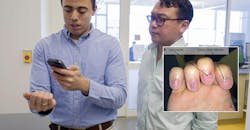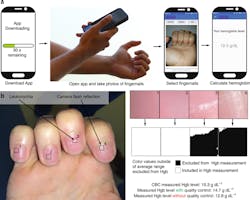Smartphone Camera Detects Anemia in Patients
Biomedical engineers at the Georgia Institute of Technology have developed a smartphone app that detects anemia without drawing blood. Instead of a blood test, the app uses photos of someone’s fingernails taken on the smartphone to determine whether the level of hemoglobin in their blood is low.
“All other ‘point-of-care’ anemia detection tools require external equipment, and represent trade-offs between invasiveness, cost, and accuracy,” says principal investigator Wilbur Lam. “This is a standalone app that can look at hemoglobin levels without having to take a blood sample.”
The Georgia Tech team notes that the app should be used for screening, not clinical diagnosis. If it indicates anemia, the patient should undergo a more thorough test.
Much of the credit for the app is being given to Rob Mannino, a Georgia Tech researcher who was motivated to conduct the research by his own experience living with beta-thalassemia, an inherited blood disorder caused by a mutation in the beta-globin gene.
“Treatment for my disease requires monthly blood transfusions,” Mannino says. “My doctors would test my hemoglobin levels more if they could, but it’s a hassle for me to get to the hospital in between transfusions to receive this blood test. Instead, my doctors currently estimate when I’m going to need a transfusion based on my hemoglobin-level trends.”
Graduate student Rob Mannino (right), pictured with Wilbur Lam (left), looks at his own fingernails using the new anemia test app. (Credit: Georgia Tech/Christopher Moore)
“This whole project couldn’t have been done by anyone but Rob,” Lam says. “He took pictures of himself before and after transfusions as his hemoglobin levels were changing, which let him constantly refine and efficiently tweak the technology on himself. So essentially, he was his own perfect initial test subject with each iteration of the app.”
The app could facilitate self-management by patients with chronic anemia, letting them monitor their disease and identify when they need to adjust their therapies or receive transfusions. That may reduce side effects or complications of transfusions that are too early or too late. It could also be used by anyone at any time and be especially appropriate for pregnant women, women with abnormal menstrual bleeding, or runners/athletes.
The app’s simplicity means it could also be useful in developing countries. Clinical diagnostic tools have strict accuracy requirements, but Mannino and Lam think that with additional research, they can eventually achieve the accuracy needed to replace blood-based anemia testing with clinical diagnosis.
Anemia is a blood condition that affects two billion people worldwide and can lead to fatigue, paleness, and cardiac distress if left untreated. The current gold standard for anemia diagnosis is known as a complete blood count (CBC).
The researchers studied fingernail photos and correlated the color of the fingernail beds with hemoglobin levels measured by CBC in 337 people: some healthy, and others with a variety of anemia diagnoses. The algorithm for converting fingernail color to blood hemoglobin level was developed with 237 of these subjects and then tested on 100.
An illustration of how the anemia test smartphone app works. (Credit: Lam/Emory/Georgia Tech)
The researchers were able to show that a single smartphone image, without personalized calibration, can measure hemoglobin levels with an accuracy of 2.4 grams/deciliter with a sensitivity of up to 97%. Personalized calibration, tested on four patients over the course of several weeks, bumps the accuracy up to 0.92 grams/deciliter, a degree of accuracy on par with point-of-care blood-based hemoglobin tests. Normal values are 13.5 to 17.5 grams/deciliter for males and 12.0 to 15.5 grams/deciliter for females.
In the app, photographing the fingernail beds (which do not contain melanin) means the test is valid for people with a variety of skin tones. The accuracy is consistent for dark and light skin tones, Mannino says. The app uses image metadata to correct for background brightness and can be adapted to phones from different manufacturers.
Mannino and Lam say they are working with a variety of doctors at Children’s and Emory—geriatric, internal medicine, neonatologists, transfusion medicine, and global health—to obtain additional data and better calibrate their system.
“This is just a snapshot of the accuracy right now,” Lam says. “The algorithm gets smarter with every patient enrolled.”
The smartphone anemia app is projected to be available commercially for public download as soon as Spring of 2019. A patent application has been filed, and Wilbur Lam and Rob Mannino have a financial interest in the success of this product.



